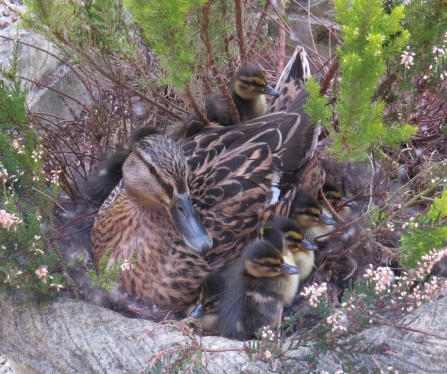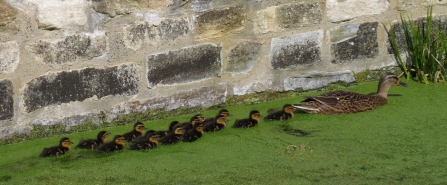In the Spring of 2016 we were surprised to discover that a mallard duck had decided that a pot of tulips in the central courtyard of the building we live in was the ideal place to raise her family. We thought she was a rather ‘daffy duck’ as the courtyard was enclosed on four sides and there was no obvious way for the ducklings to get out when they hatched and were ready to move on.
Not so daffy duck?
Mallard and ducklings by Jean Young

Duck on nest by Jean Young
Along with our neighbours we kept an eye on her progress. She flew into the courtyard and laid an egg every day or two. She was sometimes accompanied by her mate who she would have teamed up with in October/November. The eggs were disguised with whatever vegetation she could lay her beak on, some additional leaves we supplied and down plucked from her breast. Once the last egg had been laid she started incubating, only leaving the nest to visit the nearby pond to feed, drink and stretch her wings; she was often joined by her mate.

Mallard with ducklings in nest by Jean Young
Approximately 28 days after incubation begins all the eggs hatch out over 24 hours. The ducklings generally remain in the nest for at least 10 hours before Mum leads them off to water to feed. Unfortunately the day they decided to go we were out, so we missed out on the spectacle of our neighbours opening the doors and encouraging Mum and her 9 ducklings to waddle in the right direction, along the red carpet to exit the building and head for the pond.
After successfully hosting our first brood of ducklings, the ‘Nursery Wing’ obviously met with Mum’s approval as she has returned every year since (one year she visited twice). However, it hasn’t always been without incident. On her 2nd visit she left the courtyard with 11 ducklings but there were only nine when she reached the pond. After hearing some plaintive cheeping we discovered she’d gone over a drain cover and lost two down there. Armed with head torch, ladder, bucket and rope I took a trip down the drains, located the errant youngsters and passed them up to be reunited with Mum.
One year she lost a couple of eggs to magpies and the following year one sad lonely duckling was left behind when Mum departed with the rest of the brood. After waiting for a while to see if she’d come back we eventually mounted a rescue mission as a fox was looking interested. We eventually managed to capture the youngster and took it to Vale Wildlife Hospital where it joined a group of stray ducklings.
So it turns out she wasn’t such a ‘Daffy Duck’ after all, she found herself a relatively safe place to raise a family and trained her neighbours to open doors and cover up hazardous drains to help her brood on their way!

Mallard and ducklings by Jean Young
Over the years she has become a more experienced mum as this year she had a bumper brood of 15 ducklings and departed without losing any. It remains a mystery where she takes them as she only stays on the local pond overnight and then disappears.
We tend to think of her as ‘our duck’ but as the average lifespan of a mallard is three years it may not be the same one; maybe it’s one of her daughters who knows the set up!?
As the mallard is our commonest duck it is very easy to take them for granted but as a result of the decline of their populations in the wild they have recently been added to the Amber List of Birds of Conservation Concern. Reports suggest that the survival of some of our most common waterbirds are under threat due to the loss and degradation of our wetland habitats, which may explain why our duck is making use of this rather unnatural nesting site. So keep an eye out as there may be a duck coming to check out a plant pot near you!

